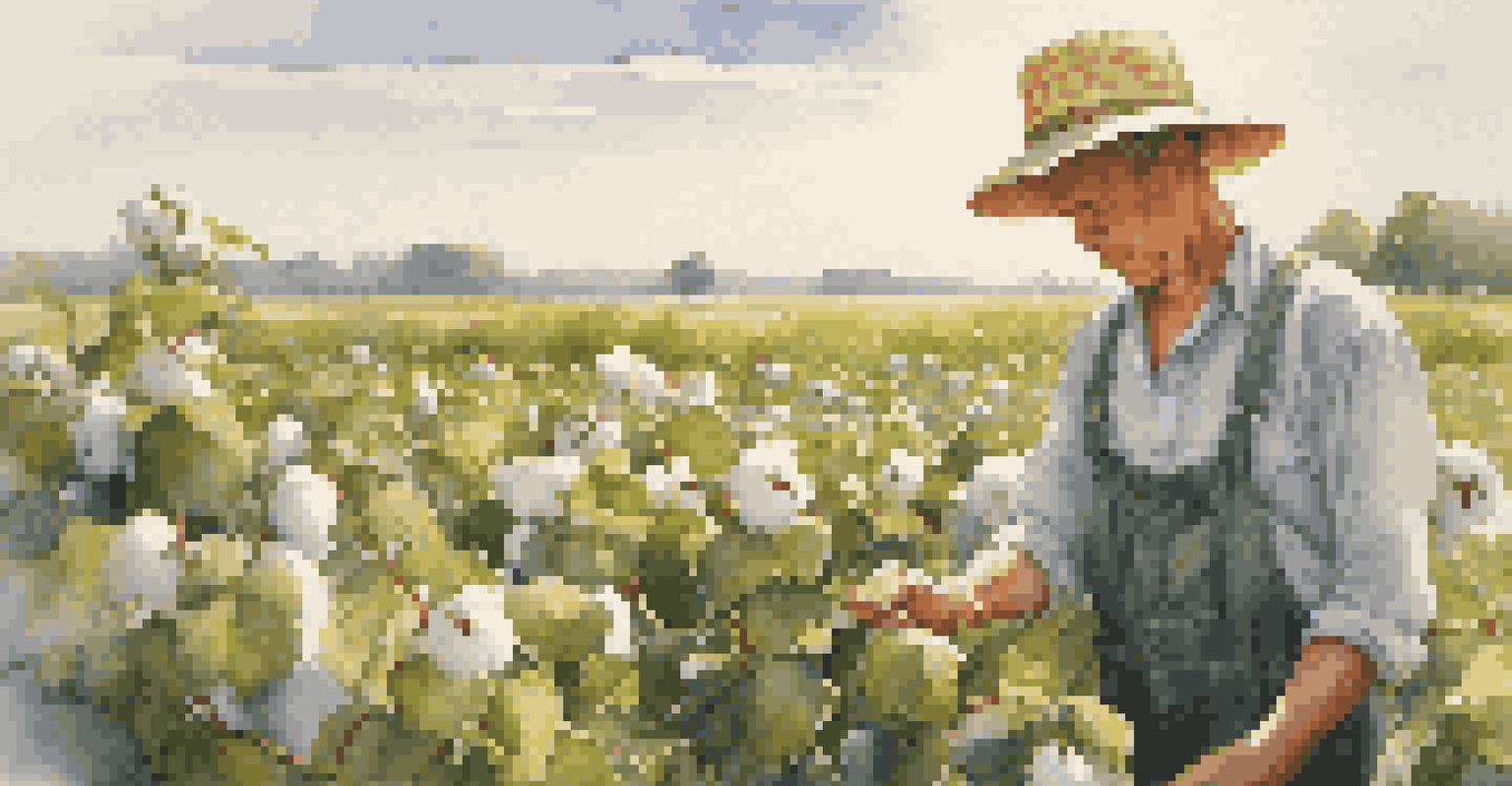Investing in Cotton: Opportunities in Agricultural Markets

Understanding the Cotton Market and Its Importance
Cotton is one of the most significant crops globally, playing a vital role in the textile industry. It’s not just a fabric; it's a source of livelihood for millions of farmers and workers. Understanding the cotton market can offer valuable insights for potential investors looking to enter agricultural markets.
Cotton is the fabric of our lives, essential not only to our wardrobes but to the livelihoods of millions.
The demand for cotton is influenced by various factors, including fashion trends and global economic conditions. As more consumers seek sustainable and organic products, the cotton market also sees shifts towards eco-friendly practices. This creates opportunities for investors who align with these trends.
Moreover, cotton is a cash crop, meaning it can provide quick returns for farmers and investors alike. With its established market infrastructure, investing in cotton is not just a financial decision but also a contribution to economic stability in farming communities.
Key Factors Influencing Cotton Prices
Several factors drive cotton prices, including weather conditions, global supply and demand, and trade policies. For example, a drought in major cotton-producing areas can drastically reduce supply, leading to higher prices. Understanding these variables is crucial for making informed investment decisions.

Additionally, technological advancements in farming practices and genetic engineering are impacting yield rates. By investing in these innovations, investors can potentially increase profitability and sustainability in cotton production. Keeping an eye on these trends can give investors an edge.
Cotton's Role in Sustainable Investing
The cotton market is increasingly attracting investors due to the rising demand for sustainable and ethical farming practices.
It's also important to consider the role of international markets. Cotton prices can fluctuate based on global competition and trade agreements, making it essential for investors to stay updated on geopolitical developments. This awareness can help investors anticipate shifts and adjust their strategies accordingly.
Sustainability and Ethical Considerations in Cotton Farming
The growing awareness of environmental issues has made sustainability a key consideration in cotton farming. Investors are increasingly looking for farms that prioritize eco-friendly practices, such as organic farming and water conservation methods. This focus on sustainability can enhance brand reputation and attract more consumers.
Investing in sustainable practices is not just good ethics; it’s good business.
Moreover, ethical considerations, such as fair labor practices, are becoming significant factors for investors. Supporting farms that provide fair wages and safe working conditions can lead to long-term profitability and community support. This ethical investment approach can also resonate well with socially-conscious consumers.
By investing in sustainable and ethical cotton production, investors not only contribute to the environment and society but also position themselves in a market that is increasingly favored by consumers. This dual benefit can create a win-win scenario for both investors and communities.
Exploring Investment Avenues in Cotton
Investors have several avenues to explore within the cotton market. Direct investments in cotton farms, shares in agricultural funds, or even futures contracts are some options available. Each avenue comes with its own risk and return profile, making it essential for investors to carefully consider their strategy.
For those new to agricultural investments, partnering with established operators or investing in cotton ETFs (Exchange-Traded Funds) can be a safer entry point. These funds typically offer diversified exposure to the cotton market, reducing individual risk. Learning about these options can help investors make informed choices.
Key Influences on Cotton Prices
Weather conditions, global supply and demand, and trade policies are critical factors that drive fluctuations in cotton prices.
Furthermore, keeping an eye on agritech innovations can open up new investment opportunities. Companies developing technologies to improve cotton yield and sustainability are likely to grow, presenting a unique chance for forward-thinking investors to get involved in the market.
Risk Management in Cotton Investments
Like any investment, cotton comes with its risks, including price volatility, natural disasters, and changes in consumer preferences. Understanding these risks is crucial for developing a robust investment strategy. Diversifying investments across different agricultural products can help mitigate potential losses.
Investors should also consider using financial instruments like options and futures to hedge against price fluctuations. These tools allow investors to set prices in advance and can protect against adverse market movements. Educating oneself on these instruments can enhance risk management strategies.
Regular market analysis and staying informed about global agricultural trends can also help investors navigate risks more effectively. By keeping a pulse on the market, investors can make timely decisions that safeguard their investments.
The Future of Cotton Investments
The future of cotton investments looks promising, especially with the increasing demand for sustainable and ethical products. As consumers continue to prioritize eco-friendly choices, cotton producers who adopt sustainable practices will likely thrive. This shift can create lucrative opportunities for investors.
Technological innovations in farming and processing are also set to reshape the cotton industry. Advancements in biotechnology and precision agriculture can lead to higher yields and lower environmental impacts. Investors who stay ahead of these trends can capitalize on the evolving landscape.
Diverse Investment Opportunities
Investors can explore various avenues within the cotton market, including direct farm investments, agricultural funds, and agritech innovations.
Moreover, as global populations grow, the demand for textiles and cotton products will continue to rise. This demographic shift ensures a sustained interest in the cotton market, making it an appealing option for long-term investors looking for growth potential.
Getting Started: Tips for Aspiring Cotton Investors
Starting your journey in cotton investments doesn't have to be daunting. Begin by educating yourself about the cotton market, its trends, and the factors affecting prices. Online resources, workshops, and agricultural conferences can provide valuable insights and networking opportunities.
Connecting with experienced investors or joining investment groups can also offer support and shared knowledge. Learning from others’ experiences can help you avoid common pitfalls and refine your investment strategy. Mentorship can be a powerful tool in navigating the complexities of agricultural investments.

Finally, consider starting small and gradually increasing your investment as you gain confidence and experience. This approach allows you to learn the ropes without overwhelming yourself. With patience and informed decision-making, you can build a successful investment portfolio in cotton.